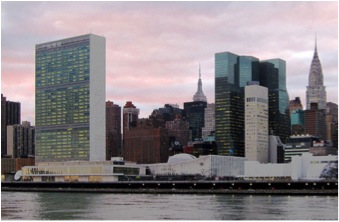Diplomacy Through Design: Touring the UN Headquarters’ Restoration
 When Michael Adlerstein LF ’86 was appointed Assistant Secretary-General and Executive Director of the United Nations Capital Master Plan in 2007, his role may have seemed to be outside the realm of the institution’s international diplomacy mandate. Yet the ambitious restoration and rehabilitation of the United Nations (UN) Headquarters proved to be an exercise in diplomacy through design, headed by Adlerstein and a team of exemplary designers and architects. Considering the UN’s unique position as an international body, housed in a building that resides in Manhattan, but isn’t governed by Federal mandates, New York State or City building regulations, the intricacies of budgeting for, designing and constructing its top-to-bottom refurbishment required a level of diplomacy worthy of the most seasoned UN negotiator. In February, the GSD hosted Josep Lluis Sert Council members for a private tour showcasing the newly unveiled renovation, led by Adlerstein, who served as a Loeb Fellow in 1986.
When Michael Adlerstein LF ’86 was appointed Assistant Secretary-General and Executive Director of the United Nations Capital Master Plan in 2007, his role may have seemed to be outside the realm of the institution’s international diplomacy mandate. Yet the ambitious restoration and rehabilitation of the United Nations (UN) Headquarters proved to be an exercise in diplomacy through design, headed by Adlerstein and a team of exemplary designers and architects. Considering the UN’s unique position as an international body, housed in a building that resides in Manhattan, but isn’t governed by Federal mandates, New York State or City building regulations, the intricacies of budgeting for, designing and constructing its top-to-bottom refurbishment required a level of diplomacy worthy of the most seasoned UN negotiator. In February, the GSD hosted Josep Lluis Sert Council members for a private tour showcasing the newly unveiled renovation, led by Adlerstein, who served as a Loeb Fellow in 1986.
The refurbishing of the UN Headquarters got its start in 2007, when the New York City Mayor’s office warned that emergency personnel and first responders might be unable to service the UN Headquarters because it was unsafe for them to enter. According the Adlerstein, the building had been declining for decades since its 1952 construction, largely because of funding shortages, the fire prevention and other building systems had become fundamentally unsafe and didn’t meet New York City building codes. Yet because neither the City nor the State had jurisdiction over the UN building, no government agency could enforce building regulations. Repairs to the building had to be voluntary, but the very real possibility of not having fire and police protection in case of a security or safety threat was a compelling motivator.
In 2008, Adlerstein and his architectural team presented the UN General Assembly—which is required to approve any UN capital improvements—a Capital Master Plan (CMP) and received $2B in funding and approval to begin renovations. With a background in historical conservation, Adlerstein, who led the effort to restore Ellis Island and the Statue of Liberty, focused on retaining the original interior appearance of the United Nations building while performing a complete update and renovation of all the building’s systems and structural elements. a top priority for the reconstruction was rendering the building as energy- and resource-efficient as possible, in keeping with UN Secretary General Ban Ki-moon’s focus on environmental conservation and climate change mitigation.
Given its unique international status, the UN building couldn’t be designated a historical landmark by any government agency, including the United Nations Environmental Social and Cultural Organization (UNESCO), but the CMP required Adlerstein and the construction team to render the building’s appearance in its original condition. The Department of Homeland Security also prohibited any of the UN’s diplomats from being relocated, given the sensitive nature of their work. This meant the building had to continue housing many UN staff and officers and operate in coordination with off-site personnel during the entire renovation, while the construction team performed a top-to-bottom restoration “down to the raw concrete” without appearing to change the building’s interior or exterior appearance.
Not surprisingly given the building’s age, renovations included removing what Adlerstein describes as ”enough asbestos to cover a football field six feet deep” from the building’s windows, ceilings and floors, among other places. In the process of the renovations, Adlerstein and his team encountered structural surprises, including perilously unstable windows and concrete flooring of dubious construction, while fortifying the building with extra steel following the 2011 bombing at the UN offices in Nigeria and repairing damage from Hurricane Sandy. New lighting, heating and ventilation, plumbing and electrical systems were installed, rendering the Headquarters 50 percent more energy efficient, and sprinkler systems were installed for the first time. The building was not only brought up to New York City and State codes, but has been awarded a LEED Gold designation. Along with systems and structural improvements, the Headquarters’ interior was burnished and restored to its original glory, including restoring wall hangings, scrubbing down limestone and marble walls and buffing and shining the terrazzo floors. The entire renovation, including the publicly visible restoration and the structural underpinnings, conforms to the United States Secretary of the Interior’s historical preservation guidelines.
To showcase Adlerstein’s and his team’s work, the Sert Council tour included the Security Council and Economic and Social Council chambers, the Secretariat tower, and the UN Delegates Lounge where they enjoyed a cocktail reception while viewing the work of a Dutch design team headed by the GSD’s Rem Koolhaas. While the vast majority of the renovations have been completed, work on the General Assembly building continues and is scheduled for completion in September. When fully restored, the UN Headquarters will represent both a design restoration success and a diplomatic accomplishment worthy of the United Nations charter.
